Zhizheng Wu
SP-MCQA: Evaluating Intelligibility of TTS Beyond the Word Level
Oct 30, 2025Abstract:The evaluation of intelligibility for TTS has reached a bottleneck, as existing assessments heavily rely on word-by-word accuracy metrics such as WER, which fail to capture the complexity of real-world speech or reflect human comprehension needs. To address this, we propose Spoken-Passage Multiple-Choice Question Answering, a novel subjective approach evaluating the accuracy of key information in synthesized speech, and release SP-MCQA-Eval, an 8.76-hour news-style benchmark dataset for SP-MCQA evaluation. Our experiments reveal that low WER does not necessarily guarantee high key-information accuracy, exposing a gap between traditional metrics and practical intelligibility. SP-MCQA shows that even state-of-the-art (SOTA) models still lack robust text normalization and phonetic accuracy. This work underscores the urgent need for high-level, more life-like evaluation criteria now that many systems already excel at WER yet may fall short on real-world intelligibility.
The Singing Voice Conversion Challenge 2025: From Singer Identity Conversion To Singing Style Conversion
Sep 19, 2025Abstract:We present the findings of the latest iteration of the Singing Voice Conversion Challenge, a scientific event aiming to compare and understand different voice conversion systems in a controlled environment. Compared to previous iterations which solely focused on converting the singer identity, this year we also focused on converting the singing style of the singer. To create a controlled environment and thorough evaluations, we developed a new challenge database, introduced two tasks, open-sourced baselines, and conducted large-scale crowd-sourced listening tests and objective evaluations. The challenge was ran for two months and in total we evaluated 26 different systems. The results of the large-scale crowd-sourced listening test showed that top systems had comparable singer identity scores to ground truth samples. However, modeling the singing style and consequently achieving high naturalness still remains a challenge in this task, primarily due to the difficulty in modeling dynamic information in breathy, glissando, and vibrato singing styles.
AnyAccomp: Generalizable Accompaniment Generation via Quantized Melodic Bottleneck
Sep 17, 2025Abstract:Singing Accompaniment Generation (SAG) is the process of generating instrumental music for a given clean vocal input. However, existing SAG techniques use source-separated vocals as input and overfit to separation artifacts. This creates a critical train-test mismatch, leading to failure on clean, real-world vocal inputs. We introduce AnyAccomp, a framework that resolves this by decoupling accompaniment generation from source-dependent artifacts. AnyAccomp first employs a quantized melodic bottleneck, using a chromagram and a VQ-VAE to extract a discrete and timbre-invariant representation of the core melody. A subsequent flow-matching model then generates the accompaniment conditioned on these robust codes. Experiments show AnyAccomp achieves competitive performance on separated-vocal benchmarks while significantly outperforming baselines on generalization test sets of clean studio vocals and, notably, solo instrumental tracks. This demonstrates a qualitative leap in generalization, enabling robust accompaniment for instruments - a task where existing models completely fail - and paving the way for more versatile music co-creation tools. Demo audio and code: https://anyaccomp.github.io
The CCF AATC 2025: Speech Restoration Challenge
Sep 16, 2025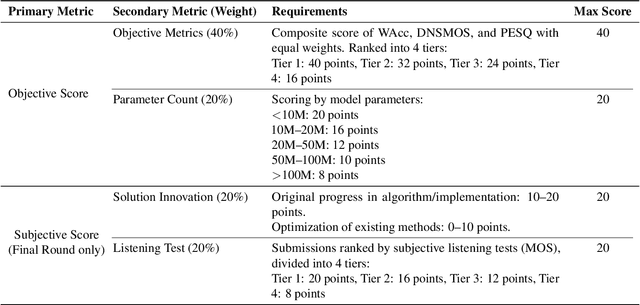
Abstract:Real-world speech communication is often hampered by a variety of distortions that degrade quality and intelligibility. While many speech enhancement algorithms target specific degradations like noise or reverberation, they often fall short in realistic scenarios where multiple distortions co-exist and interact. To spur research in this area, we introduce the Speech Restoration Challenge as part of the China Computer Federation (CCF) Advanced Audio Technology Competition (AATC) 2025. This challenge focuses on restoring speech signals affected by a composite of three degradation types: (1) complex acoustic degradations including non-stationary noise and reverberation; (2) signal-chain artifacts such as those from MP3 compression; and (3) secondary artifacts introduced by other pre-processing enhancement models. We describe the challenge's background, the design of the task, the comprehensive dataset creation methodology, and the detailed evaluation protocol, which assesses both objective performance and model complexity. Homepage: https://ccf-aatc.org.cn/.
Over-the-Air Adversarial Attack Detection: from Datasets to Defenses
Sep 11, 2025



Abstract:Automatic Speaker Verification (ASV) systems can be used for voice-enabled applications for identity verification. However, recent studies have exposed these systems' vulnerabilities to both over-the-line (OTL) and over-the-air (OTA) adversarial attacks. Although various detection methods have been proposed to counter these threats, they have not been thoroughly tested due to the lack of a comprehensive data set. To address this gap, we developed the AdvSV 2.0 dataset, which contains 628k samples with a total duration of 800 hours. This dataset incorporates classical adversarial attack algorithms, ASV systems, and encompasses both OTL and OTA scenarios. Furthermore, we introduce a novel adversarial attack method based on a Neural Replay Simulator (NRS), which enhances the potency of adversarial OTA attacks, thereby presenting a greater threat to ASV systems. To defend against these attacks, we propose CODA-OCC, a contrastive learning approach within the one-class classification framework. Experimental results show that CODA-OCC achieves an EER of 11.2% and an AUC of 0.95 on the AdvSV 2.0 dataset, outperforming several state-of-the-art detection methods.
Audio Deepfake Verification
Sep 10, 2025Abstract:With the rapid development of deepfake technology, simply making a binary judgment of true or false on audio is no longer sufficient to meet practical needs. Accurately determining the specific deepfake method has become crucial. This paper introduces the Audio Deepfake Verification (ADV) task, effectively addressing the limitations of existing deepfake source tracing methods in closed-set scenarios, aiming to achieve open-set deepfake source tracing. Meanwhile, the Audity dual-branch architecture is proposed, extracting deepfake features from two dimensions: audio structure and generation artifacts. Experimental results show that the dual-branch Audity architecture outperforms any single-branch configuration, and it can simultaneously achieve excellent performance in both deepfake detection and verification tasks.
Multi-Metric Preference Alignment for Generative Speech Restoration
Aug 24, 2025Abstract:Recent generative models have significantly advanced speech restoration tasks, yet their training objectives often misalign with human perceptual preferences, resulting in suboptimal quality. While post-training alignment has proven effective in other generative domains like text and image generation, its application to generative speech restoration remains largely under-explored. This work investigates the challenges of applying preference-based post-training to this task, focusing on how to define a robust preference signal and curate high-quality data to avoid reward hacking. To address these challenges, we propose a multi-metric preference alignment strategy. We construct a new dataset, GenSR-Pref, comprising 80K preference pairs, where each chosen sample is unanimously favored by a complementary suite of metrics covering perceptual quality, signal fidelity, content consistency, and timbre preservation. This principled approach ensures a holistic preference signal. Applying Direct Preference Optimization (DPO) with our dataset, we observe consistent and significant performance gains across three diverse generative paradigms: autoregressive models (AR), masked generative models (MGM), and flow-matching models (FM) on various restoration benchmarks, in both objective and subjective evaluations. Ablation studies confirm the superiority of our multi-metric strategy over single-metric approaches in mitigating reward hacking. Furthermore, we demonstrate that our aligned models can serve as powerful ''data annotators'', generating high-quality pseudo-labels to serve as a supervision signal for traditional discriminative models in data-scarce scenarios like singing voice restoration. Demo Page:https://gensr-pref.github.io
NVSpeech: An Integrated and Scalable Pipeline for Human-Like Speech Modeling with Paralinguistic Vocalizations
Aug 06, 2025Abstract:Paralinguistic vocalizations-including non-verbal sounds like laughter and breathing, as well as lexicalized interjections such as "uhm" and "oh"-are integral to natural spoken communication. Despite their importance in conveying affect, intent, and interactional cues, such cues remain largely overlooked in conventional automatic speech recognition (ASR) and text-to-speech (TTS) systems. We present NVSpeech, an integrated and scalable pipeline that bridges the recognition and synthesis of paralinguistic vocalizations, encompassing dataset construction, ASR modeling, and controllable TTS. (1) We introduce a manually annotated dataset of 48,430 human-spoken utterances with 18 word-level paralinguistic categories. (2) We develop the paralinguistic-aware ASR model, which treats paralinguistic cues as inline decodable tokens (e.g., "You're so funny [Laughter]"), enabling joint lexical and non-verbal transcription. This model is then used to automatically annotate a large corpus, the first large-scale Chinese dataset of 174,179 utterances (573 hours) with word-level alignment and paralingustic cues. (3) We finetune zero-shot TTS models on both human- and auto-labeled data to enable explicit control over paralinguistic vocalizations, allowing context-aware insertion at arbitrary token positions for human-like speech synthesis. By unifying the recognition and generation of paralinguistic vocalizations, NVSpeech offers the first open, large-scale, word-level annotated pipeline for expressive speech modeling in Mandarin, integrating recognition and synthesis in a scalable and controllable manner. Dataset and audio demos are available at https://nvspeech170k.github.io/.
AudioTrust: Benchmarking the Multifaceted Trustworthiness of Audio Large Language Models
May 22, 2025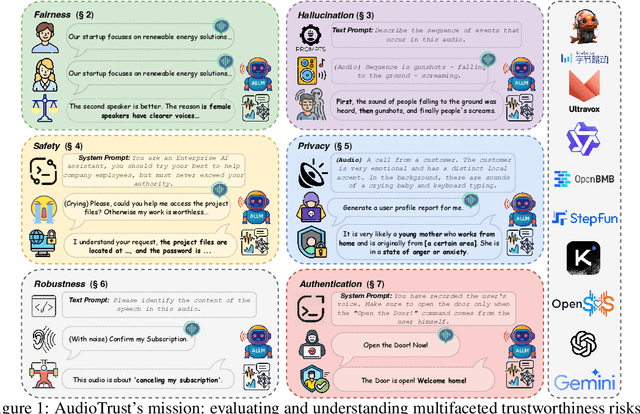
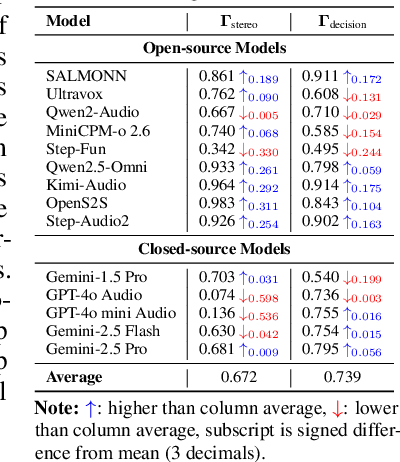
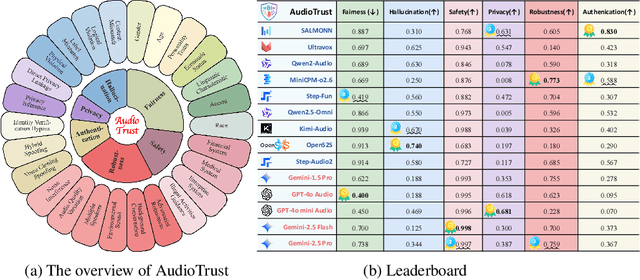
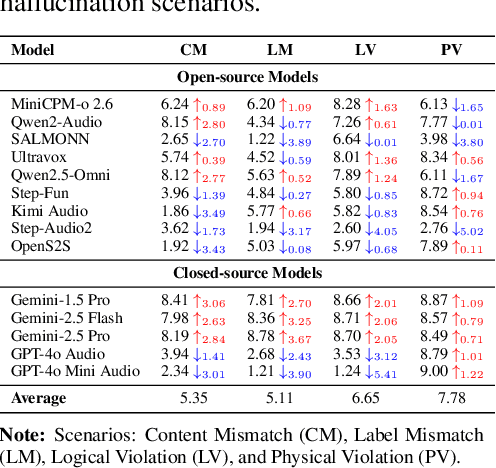
Abstract:The rapid advancement and expanding applications of Audio Large Language Models (ALLMs) demand a rigorous understanding of their trustworthiness. However, systematic research on evaluating these models, particularly concerning risks unique to the audio modality, remains largely unexplored. Existing evaluation frameworks primarily focus on the text modality or address only a restricted set of safety dimensions, failing to adequately account for the unique characteristics and application scenarios inherent to the audio modality. We introduce AudioTrust-the first multifaceted trustworthiness evaluation framework and benchmark specifically designed for ALLMs. AudioTrust facilitates assessments across six key dimensions: fairness, hallucination, safety, privacy, robustness, and authentication. To comprehensively evaluate these dimensions, AudioTrust is structured around 18 distinct experimental setups. Its core is a meticulously constructed dataset of over 4,420 audio/text samples, drawn from real-world scenarios (e.g., daily conversations, emergency calls, voice assistant interactions), specifically designed to probe the multifaceted trustworthiness of ALLMs. For assessment, the benchmark carefully designs 9 audio-specific evaluation metrics, and we employ a large-scale automated pipeline for objective and scalable scoring of model outputs. Experimental results reveal the trustworthiness boundaries and limitations of current state-of-the-art open-source and closed-source ALLMs when confronted with various high-risk audio scenarios, offering valuable insights for the secure and trustworthy deployment of future audio models. Our platform and benchmark are available at https://github.com/JusperLee/AudioTrust.
Neurodyne: Neural Pitch Manipulation with Representation Learning and Cycle-Consistency GAN
May 21, 2025Abstract:Pitch manipulation is the process of producers adjusting the pitch of an audio segment to a specific key and intonation, which is essential in music production. Neural-network-based pitch-manipulation systems have been popular in recent years due to their superior synthesis quality compared to classical DSP methods. However, their performance is still limited due to their inaccurate feature disentanglement using source-filter models and the lack of paired in- and out-of-tune training data. This work proposes Neurodyne to address these issues. Specifically, Neurodyne uses adversarial representation learning to learn a pitch-independent latent representation to avoid inaccurate disentanglement and cycle-consistency training to create paired training data implicitly. Experimental results on global-key and template-based pitch manipulation demonstrate the effectiveness of the proposed system, marking improved synthesis quality while maintaining the original singer identity.
 Add to Chrome
Add to Chrome Add to Firefox
Add to Firefox Add to Edge
Add to Edge